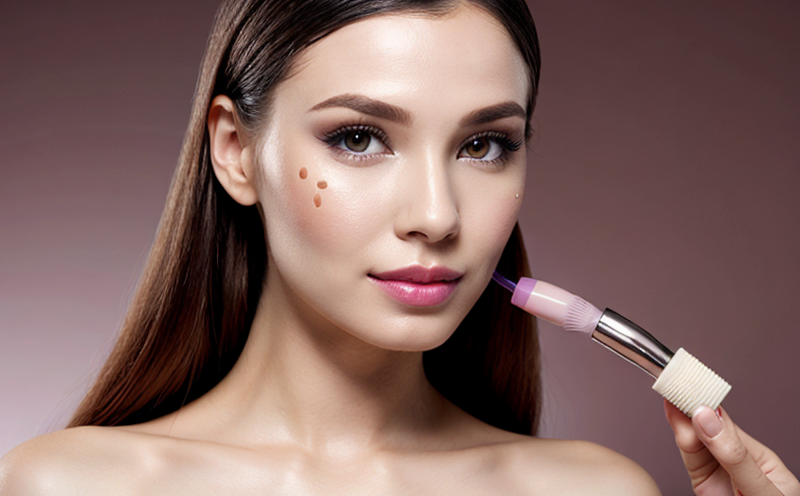In Vitro Heavy Metal Toxicity Testing in Cosmetics
In vitro testing of heavy metal toxicity in cosmetics is a critical component of modern safety and quality assurance strategies. This method leverages cell cultures or other non-animal models to assess the potential adverse effects of heavy metals present in cosmetic formulations. By using these advanced techniques, laboratories can provide data that supports compliance with regulatory requirements while minimizing ethical concerns associated with animal testing.
The process begins with careful selection and preparation of appropriate cell lines relevant to the intended use of the cosmetic product (e.g., dermal cells for topical applications). Once prepared, samples are exposed to various concentrations of heavy metals commonly found in cosmetics such as lead (Pb), mercury (Hg), cadmium (Cd), chromium (Cr), nickel (Ni), and arsenic (As). The response of these cells is then measured over time through a range of endpoints including cell viability, growth rate changes, oxidative stress markers, and gene expression profiles.
One significant advantage of in vitro testing lies in its ability to mimic human skin conditions accurately. Traditional animal models may not fully capture the complexities involved when heavy metals interact with living tissues. Moreover, this approach allows for more precise control over experimental variables, leading to reproducible results across different batches or formulations. Another benefit is reduced costs and shorter timelines compared to full-scale clinical trials.
In addition to its ethical advantages, in vitro testing also plays a crucial role in ensuring product safety by identifying potential risks early in the development process. This helps manufacturers make informed decisions about ingredient selection and formulation adjustments before products reach market shelves. Furthermore, adherence to stringent quality control measures ensures consistent performance across all manufactured batches.
From an environmental perspective, minimizing reliance on traditional animal testing methods is beneficial not only for ethical reasons but also because it reduces laboratory waste production significantly. As global regulations evolve towards stricter standards regarding cosmetic safety and efficacy, incorporating advanced in vitro techniques into the R&D pipeline becomes increasingly important.
It's worth noting that while in vitro tests are highly sensitive tools, they do have limitations. Factors such as species-specific responses or long-term effects cannot always be fully captured within this framework alone. Therefore, integrating multiple testing methodologies—such as combining in vitro studies with in vivo observations—can provide a more comprehensive assessment.
Standard operating procedures for conducting these tests adhere to internationally recognized guidelines like ISO 17025 and Good Laboratory Practice (GLP). These ensure that all experimental conditions are meticulously documented and followed rigorously, providing reliable data for regulatory submissions. Additionally, Eurolab has extensive experience in performing such tests according to relevant European Union Directives and other global standards.
The demand for safer cosmetics continues to grow as consumers become more aware of the potential health risks associated with certain ingredients. With increasing pressure on manufacturers to demonstrate not just effectiveness but also safety throughout their supply chains, robust testing protocols like those offered by Eurolab play a vital role in meeting these expectations. By offering comprehensive support from initial consultation through final report generation, our team ensures clients receive accurate and actionable insights into the heavy metal content of their cosmetic products.
Applied Standards
In vitro testing for heavy metal toxicity follows several internationally recognized standards that guide best practices in methodology and interpretation. Some key references include:
- ISO 17025:2017 – General Requirements for the Competence of Testing and Calibration Laboratories.
- GLP (Good Laboratory Practice) Regulations from various countries including EU Directive No. 2004/117/EC, US FDA regulations, and others ensure consistency in experimental design, conduct, recording, and reporting.
- OECD Guidelines for the Testing of Chemicals, specifically OECD Guideline 439 "Acute Toxicity to Daphnia magna." This guideline provides detailed protocols for evaluating acute toxicity using aquatic organisms like water fleas (Daphnia magna).
- ASTM E1876-20 Standard Practice for Determination of Mercury in Water by Cold Vapor Atomic Absorption Spectroscopy.
These standards provide clear instructions on sample preparation, reagent handling, instrument calibration, quality assurance procedures, and data analysis. Adherence to these guidelines ensures that the results obtained are valid and reliable across different laboratories worldwide.
Eurolab Advantages
Eurolab prides itself on delivering high-quality services tailored specifically for our clients' needs within the cosmetics industry. Our expertise spans not only in vitro testing but also encompasses a wide array of other analytical capabilities relevant to this sector. Here are some key advantages that set us apart:
- Comprehensive Service Offerings: From raw material sourcing through finished product evaluation, Eurolab covers every stage of the cosmetics development lifecycle.
- State-of-the-Art Facilities: Equipped with cutting-edge technology including high-resolution microscopes, advanced spectrometers, and automated sample preparation systems, our laboratories ensure accuracy and efficiency in all analyses.
- Experienced Professionals: Our team comprises highly trained scientists who stay updated on the latest research trends and regulatory changes affecting the cosmetics industry.
- Global Network: With offices across multiple continents, Eurolab offers seamless service delivery regardless of location.
- Customer Focus: Understanding that each client has unique requirements, our approach emphasizes flexibility and customization to meet specific project goals.
- Environmental Responsibility: Recognizing the importance of sustainability in all aspects of business operations, Eurolab adopts eco-friendly practices wherever possible.
The combination of these factors makes Eurolab a trusted partner for any organization looking to enhance its reputation through rigorous testing and validation processes.
Frequently Asked Questions
- ISO/IEC 17025:2017 – General requirements for the competence of testing laboratories.
- GLP (Good Laboratory Practice) Regulations from various countries including EU Directive No. 2004/117/EC, US FDA regulations, and others ensure consistency in experimental design, conduct, recording, and reporting.
- OECD Guidelines for the Testing of Chemicals, specifically OECD Guideline 439 "Acute Toxicity to Daphnia magna."
- ASTM E1876-20 Standard Practice for Determination of Mercury in Water by Cold Vapor Atomic Absorption Spectroscopy.





